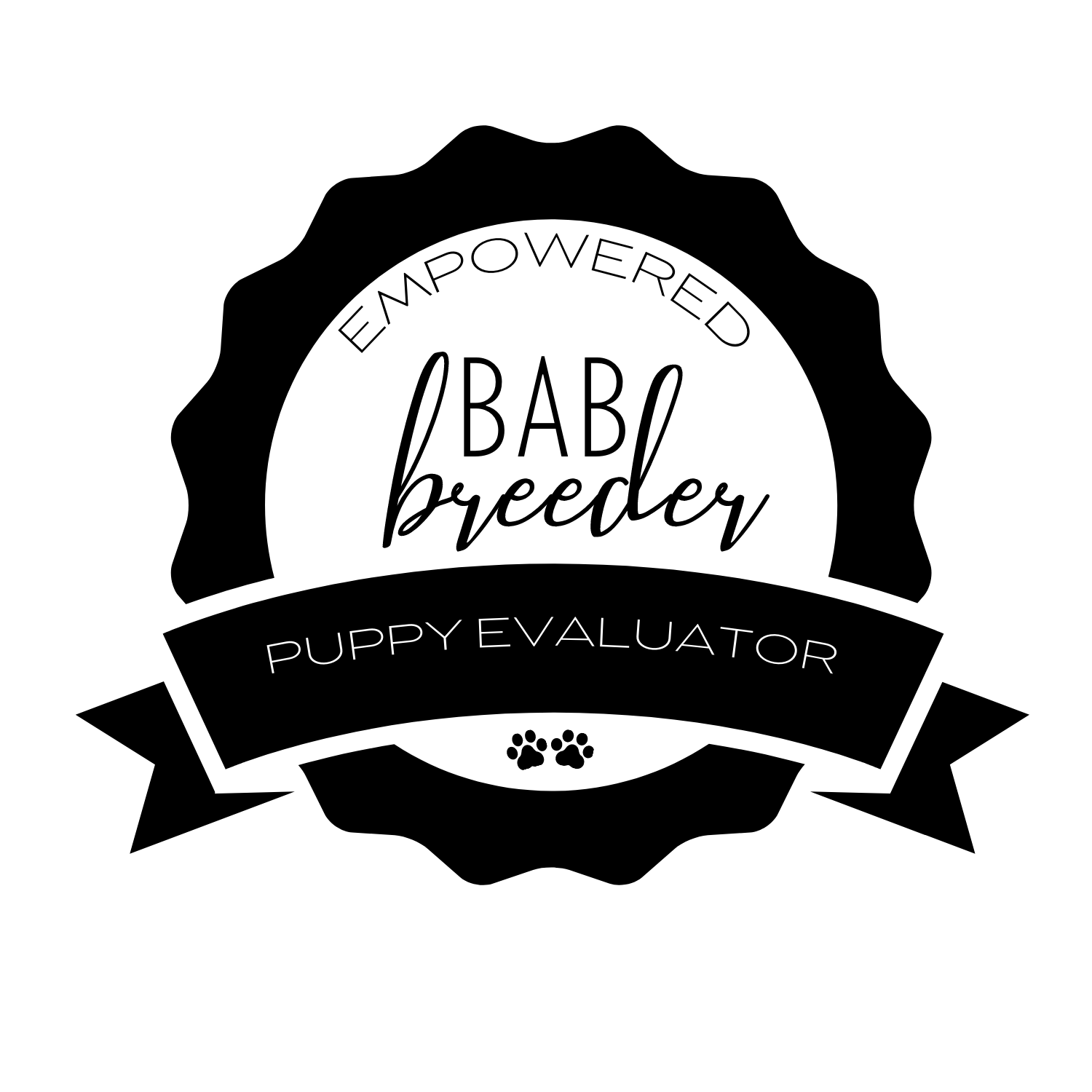 Temperament Testing
Temperament Testing

It would be so much easier for us if we could just let you choose your
puppy at birth, but that would be a terrible disservice to both you and
your puppy. We may use the Dog Evaluations to discover what your puppy
still needs help with or is sensitive to. It also helps us to
understand where your puppy's abilities lie and the type of environment
in which they would grow and fit in best. It takes a lot more time and
work to complete the Puppy Evaluations, but I am a firm believer in the
magic that happens when you find your ideal match. The dog that talks
to your heart and matches your way of life.
Some qualities in puppies are fixed (like the way the puppy is), while
others can be changed (we can shape them). While we see and record a
variety of qualities beginning at 5-6 weeks of age, the following are
the most important ones we look for during our testing: |
Stable Traits:
Assertiveness (with humans and dogs)
-how at ease a dog is around people. Do they adamantly resist human
power (high) or do they simply yield to it (low)? We watch to see if
the puppy approaches the tester on its own impulse without the tester
engaging in conversation with them to try this.
Motivation
-Does the dog want to labor for people naturally? During this part of
the exam, the puppy will be instructed to play fetch, pull at the
person's clothing, and interact with them. Does the dog do as the
tester asks, or does the individual have to exert a lot of effort to
train the puppy to comply?
Energy Level -How animatedly does the dog move throughout the test? Do
they take pauses and relax, or do they roam around all the time?
Prey Drive
-Five distinct behaviors are involved in prey drive: seeking, watching,
pursuing, biting to capture, and biting to kill. These habits vary by
type among canine species with strong levels of prey drive. Hounds
prefer to pursue and flush out targets, whereas herding breeds have a
strong chasing urge. How eager is the dog to pursue, spot, and pounce
on tiny animals? Low indicates that the puppy has no interest in
hunting, while high indicates that they can be taught to scavenge and
should be kept away from tiny animals. (birds, ferrets hamsters, etc.)
Human Focus
- How eager are they to pay heed to the person and "follow the pack"?
Low scores indicate a desire to learn on one's own, while high scores
indicate a concentration on people and attention to them.
Tenderhearted
- When a person has an emotional outburst, to what extent are the
puppy's feelings overwhelming? Scores of "not tenderhearted" indicate
that the dog is not influenced by the owner's emotions. Extremely
tenderhearted canines will "feel" with their owners and are incapable
of handling emotionally fraught situations. A canine with a very
tenderhearted shouldn't be an ESA because it would feel just as
overwhelmed as a person. The finest emotional support canines have a
medium to high level of tenderheartedness. |
Adjustable Traits:
Confidence
-How self-assured is the canine about its prowess in unfamiliar
settings? How does the dog react when it enters the assessment area to
the strange surroundings and objects?
Nerve Strength/ Resiliency -How
does the canine respond under pressure and in various scenarios? High
means they are able to adjust more readily to stressful circumstances,
while low means they are easily stressed. Throughout the exam, the
puppy's nerve strength is monitored, and we look to see how they
respond to stress and whether they can face their anxieties.
Touch Tolerance (compliance only-not if they like it)
-How does the dog respond when it is rough-housed? (have their tail
tugged, toes touched, etc.) High scores indicate that the dog was
relaxed the entire time and liked being touched, while low scores
indicate that the puppy doesn't manage unwanted contact well. This part
of the exam will be appealing to many of the pups.
Sound Sensitivity
-Does the puppy readily flinch at sudden, startling noises? High scores
indicate that the puppy is susceptible to loud sudden sounds, while low
scores indicate that the puppy has a high tolerance for loud noises.
Sight Sensitivity
-When there is an unanticipated disturbance, how anxious is the puppy?
Low means they are not readily stressed by visual cues, whereas high
means they may conceal if they notice something unexpected, like an
exposed umbrella.
|
 The Badass Breeders Curriculum we utilize aids in the development of
our puppy's adaptable characteristics. It aids in the development of
confident pups who are bold and fast to recover when startled; they are
cooperative when touched all over; and they manage new noises and
sights well since we work hard to desensitize them to things that would
commonly shock puppies at a later age. It's awe-inspiring and
delightful to witness our puppies grow self-assurance and faith in
humans. Our objective is to instill in our pups the belief that the
world is a safe place, that humans are nice, and that dogs are friendly.
The Badass Breeders Curriculum we utilize aids in the development of
our puppy's adaptable characteristics. It aids in the development of
confident pups who are bold and fast to recover when startled; they are
cooperative when touched all over; and they manage new noises and
sights well since we work hard to desensitize them to things that would
commonly shock puppies at a later age. It's awe-inspiring and
delightful to witness our puppies grow self-assurance and faith in
humans. Our objective is to instill in our pups the belief that the
world is a safe place, that humans are nice, and that dogs are friendly.
We try our best to get to know our puppies' personalities as well as
the needs of their new families, but this does not rule out the
possibility that the puppies will change with time. A more quiet puppy
may emerge out of his shell and exhibit more confidence with the
correct home, patience, and training. A fun-loving and confident puppy,
on the other hand, may grow more apprehensive after a poor encounter
with a nervous dog. Home training is critical for a smooth transfer and
a happy home life! |
 | | |
|


 The Badass Breeders Curriculum we utilize aids in the development of
our puppy's adaptable characteristics. It aids in the development of
confident pups who are bold and fast to recover when startled; they are
cooperative when touched all over; and they manage new noises and
sights well since we work hard to desensitize them to things that would
commonly shock puppies at a later age. It's awe-inspiring and
delightful to witness our puppies grow self-assurance and faith in
humans. Our objective is to instill in our pups the belief that the
world is a safe place, that humans are nice, and that dogs are friendly.
The Badass Breeders Curriculum we utilize aids in the development of
our puppy's adaptable characteristics. It aids in the development of
confident pups who are bold and fast to recover when startled; they are
cooperative when touched all over; and they manage new noises and
sights well since we work hard to desensitize them to things that would
commonly shock puppies at a later age. It's awe-inspiring and
delightful to witness our puppies grow self-assurance and faith in
humans. Our objective is to instill in our pups the belief that the
world is a safe place, that humans are nice, and that dogs are friendly.




